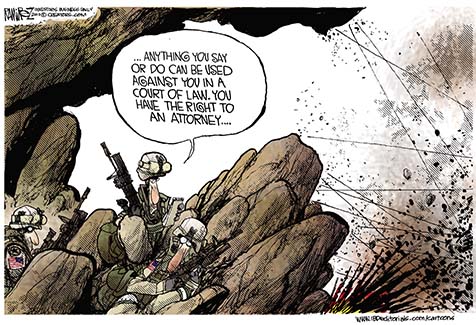Jan.12.2010
1:13 pm
by Ed Beakley
EEI#23 “What kind of war?” -continued (9 of ?) – Square Pegs, Round Holes vs. “War Amongst the People”
Essential Elements of Information for a Culture of Preparedness
There seems to be a trend toward treating events of terrorism as if they were specifically a law-enforcement problem , rather than enemy operations in the context of war and warfare. Both require application of force “but for force to be effective the desired outcome of its use must be understood in such detail that the context is defined as well as the point of application.” (The Utility of Force; The Art of War in the Modern World by General Sir Rupert Smith)
The issue here is not crime or war, the context is rather that war plays out “amongst the people” – not only in the villages of Afghanistan, but as readily in the airports, cities, communities, and courtrooms of all nations. The application of force, -whether by police or military – AND of law are essential.
Consider the following 3 new points (original list provided in EEI# 15) based on the Christmas Day attempted airline bombing:
- In the wake of the failed Christmas Day airplane bombing, President Obama ordered speedy reviews of how the air security system failed and the Transportation Security Administration began enhanced screening for passengers traveling through 14 nations.
- Eight years after WTC and Pentagon attacks, actionable intelligence still can’t seem to get across intelligence agency boundaries so as to create “action.”
- Nigerian-born Umar Farouk AbdulMutallab who tried to detonate explosives hidden in his underwear as a Northwest Airlines flight from Amsterdam, Netherlands, made its approach to Detroit, Michigan has been read his Miranda rights.
The 1648 Treaty of Westphalia at the end of the Thirty Year War essentially made war and warfare a function of the state and was in part at least an attempt to limit or control devastation among non-combatants. The 1949 Geneva Conventions set the standards in international law for the humanitarian treatment of the victims of war and established the qualifications for being considered a lawful combatant – must have conducted military operations according to the laws and customs of war, be part of a chain of command, wear a “fixed distinctive marking, visible from a distance” and bear arms openly.
Does not the above list give one pause to think, that maybe, just maybe in light of those long standing and current established rules and protocols, we are laboring most vigorously, quoting General George Patton, to make circumstances meet the plans and rules, rather than adapting as necessary to a very complex and dynamic set of events. Former CIA Chief of the bin Laden Issue Station, Michael Scheuer, asked are we in a war or chasing Thelma and Louise? The answer would appear to be BOTH, and without succinct definition of the specific kind of war as back-plane for understanding events as they occur and without either usable definition or following rules, we’re continually trying to shoe horn square pegs in round holes.
It seems appropriate here to reflect upon some of the introductory words in General Smith’s The Utility of Force: The Art of War in the Modern world:
On every occasion that I have been sent to achieve some military objective in order to serve a political purpose, I, and those with me, have had to change our method and reorganize in order to succeed. Until this was done we could not use our force effectively.
… it became obvious to me that the extant theories of military organization and application and the unfolding realities were wide apart. No more was I part of a world of wars in which the civilian and military establishments each had its distinct role in distinct stages. The new situations were always a complex combination of political and military circumstances, though there appeared to be little comprehension as to how the two became intertwined – nor far more seriously from the perspective of the military practitioner, how they constantly influenced each other as events unfolded…. I realized we were now in a new era of conflict – in fact a new paradigm –
… from armies with comparable forces doing battle on a field to strategic confrontation between a range of combatants, not all of which are armies, and using different types of weapons, often improvised. The old paradigm was that of interstate industrial war. The new one is the paradigm of war amongst the people.
And so, what does “war amongst the people” as definition signify in regard to overseas contingency operations, the Long War, counter-insurgency (COIN), counter terrorism, nation building, fourth generation warfare, or what we’re doing in Afghanistan? Are we in a global war on terrorism, a hybrid war, an irregular war, a guerrilla war, an asymmetric war? Or is it just “war” as Clausewittz defined it based on Napoleonic times ingrained with an inherent element of constant change?
The next post will provide some discussion of these terms by way of seeking at least a reference point of terminology .
Filed in 4GW,Culture of Preparedness,Elements of Essential Information,Terrorism,Uncategorized,What Kind of War,What Kind of War The Series | Comments Off
